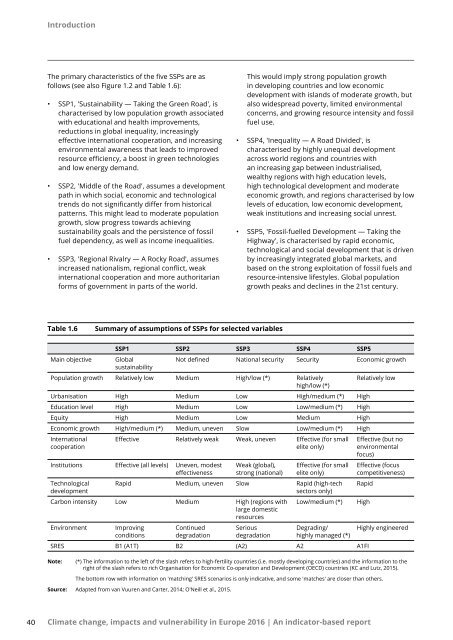Climate change impacts and vulnerability in Europe 2016
document
document
You also want an ePaper? Increase the reach of your titles
YUMPU automatically turns print PDFs into web optimized ePapers that Google loves.
Introduction<br />
The primary characteristics of the five SSPs are as<br />
follows (see also Figure 1.2 <strong>and</strong> Table 1.6):<br />
• SSP1, 'Susta<strong>in</strong>ability — Tak<strong>in</strong>g the Green Road', is<br />
characterised by low population growth associated<br />
with educational <strong>and</strong> health improvements,<br />
reductions <strong>in</strong> global <strong>in</strong>equality, <strong>in</strong>creas<strong>in</strong>gly<br />
effective <strong>in</strong>ternational cooperation, <strong>and</strong> <strong>in</strong>creas<strong>in</strong>g<br />
environmental awareness that leads to improved<br />
resource efficiency, a boost <strong>in</strong> green technologies<br />
<strong>and</strong> low energy dem<strong>and</strong>.<br />
• SSP2, 'Middle of the Road', assumes a development<br />
path <strong>in</strong> which social, economic <strong>and</strong> technological<br />
trends do not significantly differ from historical<br />
patterns. This might lead to moderate population<br />
growth, slow progress towards achiev<strong>in</strong>g<br />
susta<strong>in</strong>ability goals <strong>and</strong> the persistence of fossil<br />
fuel dependency, as well as <strong>in</strong>come <strong>in</strong>equalities.<br />
• SSP3, 'Regional Rivalry — A Rocky Road', assumes<br />
<strong>in</strong>creased nationalism, regional conflict, weak<br />
<strong>in</strong>ternational cooperation <strong>and</strong> more authoritarian<br />
forms of government <strong>in</strong> parts of the world.<br />
This would imply strong population growth<br />
<strong>in</strong> develop<strong>in</strong>g countries <strong>and</strong> low economic<br />
development with isl<strong>and</strong>s of moderate growth, but<br />
also widespread poverty, limited environmental<br />
concerns, <strong>and</strong> grow<strong>in</strong>g resource <strong>in</strong>tensity <strong>and</strong> fossil<br />
fuel use.<br />
• SSP4, 'Inequality — A Road Divided', is<br />
characterised by highly unequal development<br />
across world regions <strong>and</strong> countries with<br />
an <strong>in</strong>creas<strong>in</strong>g gap between <strong>in</strong>dustrialised,<br />
wealthy regions with high education levels,<br />
high technological development <strong>and</strong> moderate<br />
economic growth, <strong>and</strong> regions characterised by low<br />
levels of education, low economic development,<br />
weak <strong>in</strong>stitutions <strong>and</strong> <strong>in</strong>creas<strong>in</strong>g social unrest.<br />
• SSP5, 'Fossil-fuelled Development — Tak<strong>in</strong>g the<br />
Highway', is characterised by rapid economic,<br />
technological <strong>and</strong> social development that is driven<br />
by <strong>in</strong>creas<strong>in</strong>gly <strong>in</strong>tegrated global markets, <strong>and</strong><br />
based on the strong exploitation of fossil fuels <strong>and</strong><br />
resource-<strong>in</strong>tensive lifestyles. Global population<br />
growth peaks <strong>and</strong> decl<strong>in</strong>es <strong>in</strong> the 21st century.<br />
Table 1.6<br />
Summary of assumptions of SSPs for selected variables<br />
SSP1 SSP2 SSP3 SSP4 SSP5<br />
Ma<strong>in</strong> objective Global<br />
Not def<strong>in</strong>ed National security Security Economic growth<br />
susta<strong>in</strong>ability<br />
Population growth Relatively low Medium High/low (*) Relatively<br />
Relatively low<br />
high/low (*)<br />
Urbanisation High Medium Low High/medium (*) High<br />
Education level High Medium Low Low/medium (*) High<br />
Equity High Medium Low Medium High<br />
Economic growth High/medium (*) Medium, uneven Slow Low/medium (*) High<br />
International<br />
cooperation<br />
Effective Relatively weak Weak, uneven Effective (for small<br />
elite only)<br />
Institutions Effective (all levels) Uneven, modest<br />
effectiveness<br />
Technological<br />
development<br />
Weak (global),<br />
strong (national)<br />
Effective (for small<br />
elite only)<br />
Rapid Medium, uneven Slow Rapid (high-tech<br />
sectors only)<br />
Carbon <strong>in</strong>tensity Low Medium High (regions with<br />
large domestic<br />
resources<br />
Environment<br />
Improv<strong>in</strong>g<br />
conditions<br />
Cont<strong>in</strong>ued<br />
degradation<br />
Serious<br />
degradation<br />
Low/medium (*)<br />
Degrad<strong>in</strong>g/<br />
highly managed (*)<br />
SRES B1 (A1T) B2 (A2) A2 A1FI<br />
Effective (but no<br />
environmental<br />
focus)<br />
Effective (focus<br />
competitiveness)<br />
Rapid<br />
High<br />
Highly eng<strong>in</strong>eered<br />
Note:<br />
(*) The <strong>in</strong>formation to the left of the slash refers to high-fertility countries (i.e. mostly develop<strong>in</strong>g countries) <strong>and</strong> the <strong>in</strong>formation to the<br />
right of the slash refers to rich Organisation for Economic Co-operation <strong>and</strong> Development (OECD) countries (KC <strong>and</strong> Lutz, 2015).<br />
The bottom row with <strong>in</strong>formation on 'match<strong>in</strong>g' SRES scenarios is only <strong>in</strong>dicative, <strong>and</strong> some 'matches' are closer than others.<br />
Source: Adapted from van Vuuren <strong>and</strong> Carter, 2014; O'Neill et al., 2015.<br />
40 <strong>Climate</strong> <strong>change</strong>, <strong>impacts</strong> <strong>and</strong> <strong>vulnerability</strong> <strong>in</strong> <strong>Europe</strong> <strong>2016</strong> | An <strong>in</strong>dicator-based report


